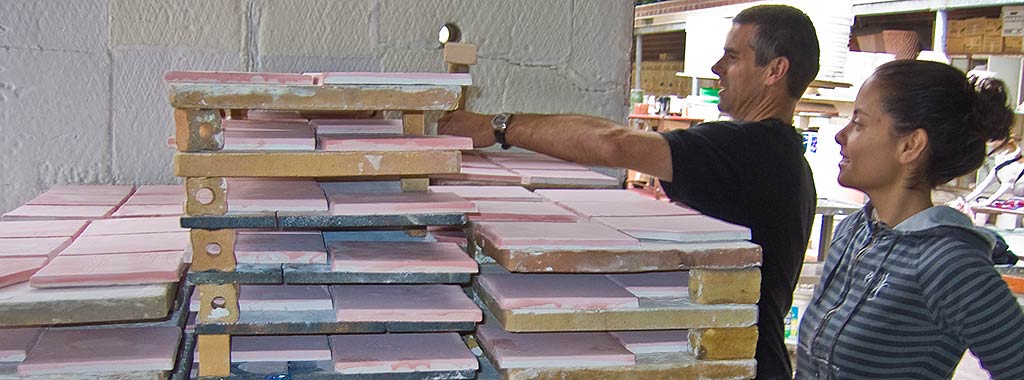
These notes--still largely unedited--record the events of Fullerton College's visiting artist week for 2009. The work by Sandow Birk and his collaborator, Elyse Pignolet, took place in room 1021 of the Art Building, and in the Ceramics yard.
Monday, March 16, 2009, 9 am.
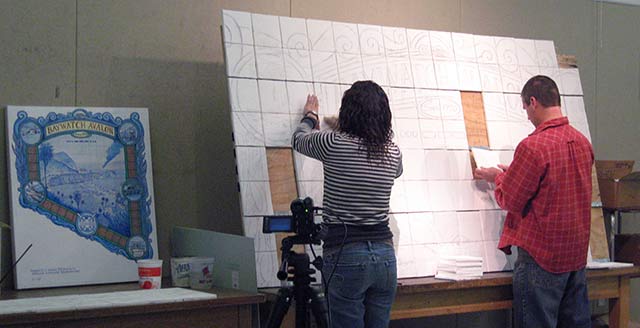
Getting ready at the beginning of the first day. Photo by Terri Santana.
- Tiles being set up on rack as audience enters. Gridded cartoon nearby. Mostly azulejos colors (blue and white).
- Tile mural for new lifeguard headquarters building in Avalon (headlined "Baywatch Avalon"--it's the lifeguard station that the TV serial was named after). Project funded by 1 percent for art program. This project was open to anyone from the state of California. Selected out of six finalists by a group of art world, lifeguards, and community representatives.
- Tiles supposed to go up in May-June, depending on construction delays. Work on this project has been going on for about a year now. Trapezoid shape to fit above outside staircase. 2nd floor of building houses lifeguards, who commute from L.A. Discussed with lifeguards the contents. Lifeguards emphasized their multiple capabilities (they have to make up for Catalina's lack of a hospital, as well as support large community of scuba divers), and were particular about hardware details depicted (helicopters, rescue boats).
- They had to satisfy conflicting requirements--lifeguards wanted to be shown doing brave acts, but the city didn't want anything disturbing. Found a compromise solution by taking an idea from Bruegel the Elder's "Fall of Icarus" (Icarus is only a tiny splash off in a corner, in a sea that is in the distance behind an everyday medieval scene of a farmer plowing). Thus, he added a distant detail of boats on fire, with rescuers approaching.
- Fixed budget for the project ($30,000)--regardless of who does the project. All costs must be covered by that budget. Must pay also for installation (including paying for $1M insurance for the installer, and guaranteeing that it won't come off the wall for a year).
- Birk describes the works' relationship to blue and white tile painting tradition (both artists visited Portugal to see examples).
- Up to approx WWII a tile company operated on Catalina, and tiles it manufactured can be seen throughout the city. Birk and Pignolet will buy tiles reproducing the factory's characteristic style from the 1920s and incorporate them in the border of the mural.
- Border design: kelp, marine life, sailor's knot, SOS dash-dots.
- Bisque fired handmade Mexican tiles. Irregularities will cause the glaze to be uneven and catch the light and sparkle.
- Bill Henke, Fullerton College ceramics instructor, brings in color sampler just fired in the FC kilns. Every kiln is different, so it is important to test each time. The color came out less intense than they expected. They consider using more coats (each additional coat deepens the color). Test fired at cone 06, 1850 degrees F.
- Starts with underglaze colors. Will afterwards be covered with transparent glaze.
- Medium fire glaze yields more stable colors. Pots with "drippy" glaze are likely high fire.
- They built the rack themselves using drywall metal corners. They are thin enough that they won't stick out beyond the tiles and snag the brush.
- Pencil marks don't need to be erased from the tiles before painting because they will burn off in the firing.
- Start off by outlining color areas along pencil marks. The paint dries extremely quickly and looks chalky once it dries. He hasn't used them for about a year, and it takes some time getting used to it. Go on to fill flat color fields.
- More concerned with the ideas behind the projects rather than being picky about supplies. He gets overly nervous about the project if he's using an expensive piece of paper. Just came back from Germany, where he had two shows. It all started with a Smithsonian residency in DC. The first awardee was Saul Steinberg, who used the money to get drunk all the time, so they cancelled the program. When the program was revived a couple of years ago, they "hadn't thought about the need for a studio", so he was given a cubicle. He ended up working on loose sheets with ballpoint or anything else available. He kept taping on additional sheets, and it turned into a 9ft drawing that is now hanging in Germany.
- The theme of the drawing is the U.S. Constitution (a departure from earlier L.A.-centric work). He was drawn to the topic simply because it was a tourist attraction in the area that couldn't be ignored. He hadn't read the Constitution before, and thought of it as something "from Ben Franklin's time". He realized how much impact it has on everyday life today, and decided to represent it as vignettes of contemporary America.
- The drawing was taken to the London Art Fair by his L.A. gallery. It was seen by a Heidelberg curator, who put it in a group show. Wrote him and sent him some of his books, and eventually got a solo show out of it. While in Germany, he also went to the opening of the group show, which in the meanwhile had traveled to Berlin.
- Planning ahead to later projects--two big shows of paintings coming up later in the year. Always planning ahead to the next project. This is the fourth public art project of six lined up so far. They apply to about one project a month--estimate they've applied to about 100 so far over approximately 10 yrs. Their low success rate doesn't deter them--handling paperwork is a big part of their daily routine.
- A previous public art project, also ceramics, was for an orange line transit station in the Valley (Tarzana). It was only a $10K budget, and because of all the delays it was financially almost not worth it. They were able to come up with a distinguishing design working with the Tarzan theme (Burroughs ranch was in the area). The actual fabrication was done by the builders of the station.
- Prefer tiles because it is a practical medium for public art--durable, and graffiti-proof (paint can be scrubbed off with steel wool).
- Went to school at Otis when it was still in a ratty neighborhood downtown, and it was a great experience. He did take 8 years to finish his 4-yr degree. After graduating he rented a storefront as a studio in South-Central, and worked three days a week so he could paint. The employer was an art mover, so he drove everyday to museums and galleries, and especially saw how many people collect art and have houses full of great works. Daily contact with gallery personnel was invaluable later on to get them to look at his portfolio.
- In Europe, Birk noticed that the tiles of ceramic murals are installed without grout, butting up. They would prefer to have it done that way, but installers here claim it can't be done.
- The Dante's Inferno project started out from buying a $4 copy at a used bookstore, drawn primarily by Gustave Doré's illustrations. He started reading bits and pieces during TV commercial breaks and eventually, intrigued by the text, decided to set the story in his surroundings.
- $7K budget for first movie ("In Smog and Thunder", fake documentary on war betwen L.A. and S.F. spoofing PBS civil war documentaries), which was quite simple but garnered praise at film shows. It was made just for fun with friends, one a filmmaker with computer experience, and a puppeteering instructor.
- Decided to go on to something more complex for the Inferno project, for which they raised money from a Silicon Valley entrepreneur who had bought some of Birk's Inferno painting. 50 people (45 unpaid) working for 3 yrs. All puppets made by Birk and Elise. Puppeteering done by Cal Arts students. Were told to look for celebrity voice talent to improve their commercial chances. First person to say yes was Viggo Mortensen, who eventually had to leave but helped them find replacement. The film was shown at Slamdance, and may other venues--a total of 25 festivals in London, Amsterdam, NYC, and elsewhere. In spite of also being shown on TV and made available on DVD, it has yet to break even.
- A student points out that one of the tiles they are painting is in the wrong place. Problem can be fixed easily--the color can be taken off with a sponge.
- "Leading causes of death" project came from a news item heard on the radio. Set it aside as a possible good idea for after graduation.
- Never considered being an artist until he went to college. Didn't think you could have a career doing that. In high school he was geting ready for architecture, but had a hard time with the math rrequirements. On a whim he went on a tour of Otis, and found the atmosphere of art school much more congenial.
- Grew up in Seal Beach, surfing lifestyle still a big influence. Easygoing attitude helped him to get over the fear of not having a "proper" job.
- Birk believes that the use of popular media devices in his art has helped him with the critics.
- Did a semester in Paris as an exchange student, but was "bummed out" because of the distance from the shore. So the next semester he transferred to the Bath Academy of Art, which is close to Mumbles, a surf spot near Swansea in Wales. Even though his choices were dictated by other concerns, they ended up changing his outlook on art. In L.A., painting tiny pictures in a garret seemed like a ridiculous occupation overshadowed by the movie industry. But experiencing art first-hand in Europe (including "paintings bigger than a movie screen") energized him to persevere with painting and make art that matters even in this day and age.
- Believes that the situation for artists in L.A. is much improved since he graduated. He thinks that today's graduates are no longer faced with the dilemma of moving to New York--they can establish careers right here.
- He worked on the Iraq project from generally available news images. Did not want to make something only about the specifics of the situation in Iraq, or a generic "hate the war" statement. His series on prisons also had aspirations to attain more general significance, though he did travel to prisons throughout California.
Monday, March 16, 2009, 1 pm.
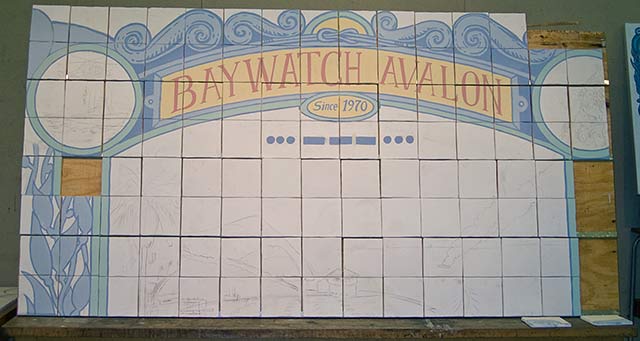
The mural at the end of the first day of work.
- In today's painting session, Birk and Pignolet are focusing initially on the "easy stuff"--the ornamental details around the edge of the mural. Before attempting the more painterly matter they need some practice with a medium they have not used for a while.
- Birk provides additional details on the selection process for awarding present project. Selection process involved a 30 minute interview (presentation and Q&A). Interviewers concerned with track record (demonstrate ability to be able to complete the project on spec and on time), but also with the artist's conceptual development of the theme of the project. Safety issues also affect type and siting of the work.
- Gaining the first public art commission is difficult because of the lack of track record. Pignolet had worked as an assistant on a number of public art projects, and that gave them a point of entry.
- Birk has often had to argue against commissioner's ideas about public art. Does not agree with current trend towards participative works that reflect the history of the place and accommodate inputs from all stakeholders. Feels that the most successful public art makes a stand-alone statement--cites Oldenburg's clothespin, and the Eiffel Tower.
- L.A. Cultural Affairs Department sends out calls for public art proposals.
- City will not write checks unless contracting artist has business status, so Birk and Pignolet had to take out a business license for a year to work on the project.
- Birk has worked on a private commission (from the person funding the Inferno movie), but is not actively seeking new ones.
- His work outside public art is different primarily because he doesn't stop to consider commercial viability. A prime example is the series on "leading causes of death"--not a popular topic. The artwork went on display in four shows, thus considered a success even though it earned little. He wasn't trying to "educate" viewers. He was mostly intrigued by the classification of such matters, the unexpectedness and the self-inflicted nature of some causes of death (Birk himself does not smoke). The project did become a reflection on life in America because each cause of death is represented by a portrayal of the most affected group.
- Having disturbing work (Lorena Bobbitt painting) in his oeuvre has not deterred commissioners. The approval process is such that he cold not "sneak in" undesirable images. Whatever radical ideas he may start with will have to be modified until all stakeholders are satisfied.
- Development of the design for the mural started with the grid representing the tiles. The actual tiles purchased are a smaller size, so a black and white diagram was drawn (also on display in the demonstration next to the image used as a guide for colors). Total of 274 tiles. May add beveled edge tiles--to be likely decided at a meeting with the builders.
- After working in an art moving business, Birk got gallery jobs, which was an improvement because of the shorter hours and because of the work he did in each gallery (painting the walls, hanging shows). He also got to meet 80's art world icons like Julian Schnabel, which gave him insights on the workings of the art world as he hung their shows.
- Earl McGrath, former music promoter and Hollywood socialite, founded a gallery (still in operation, at Melrose & Robertson) mostly as a hobby--without regard for profitability. Birk was working for him when he "was given" his first show. While he staffed the gallery alone, Art Scene magazine called requesting a list of the next three shows. He could only find two shows on the gallery's calendar, so he ad-libbed a third--of emerging artist Sandow Birk's paintings. McGrath was amused by the episode and let the show take place--in spite of never having looked at Birk's work before.
- Birk dropped out of school about three times (he eventually graduated with a BFA). On one trip, about 20 yrs ago, he and a friend attempted to drive from an old jeep from California to Brazil to participate in Carnaval. While the car died in Guatemala, they still made it to Rio traveling by bus. They arrived a day before Carnaval started, and remained for a memorable stay.
- Birk has lately focused less on themes specific to California, favoring topics that resonate elsewhere, such as the Iraq War project that is on display in Germany. He now plans projects with the exhibition venue in mind--he shows regularly at three galleries, in L.A., S.F., NYC.
- Birk's next major show is actually two simultaneous shows in L.A. and S.F., but the project (based on the Quran) is very large and may extend beyond the shows. He is well aware of the possibility for controversy, but he does not anticipate death threats--the work is not critical of Muslim scripture, rather he seeks to spread knowledge of the actual contents of this influential book. He has been working on the Quran project for three years already, researching Islamic calligraphy and imagery. He chanced upon a major resoure during a surfing trip to Ireland--the Chester Beatty Library in Dublin, which has extensive holdings of copies of the Quran from different ages.
- For the Inferno movie, Birk and Pignolet settled on the technique of paper puppets at the prompting of their collaborator, Paul Zaloo, and as the most attainable. They ruled out live action for its complexities, traditional animation for the large amount of work involved, and computer animation for lack of expertise. It still turned into a huge undertaking, and they were still building puppets when shooting started. This however allowed them to make changes prompted by ideas that emerged during photography.
- Birk's web site hasn't been updated for some four years, but the three galleries that represent him have a substantial web presence that makes up for it. The galleries shoulder some of the business workload, but only if there is a return for the gallery. Public art and shows overseas must be handled by the artist.
- Birk recently started doing print originals (those that exist only as a print, not as a reproduction of a painting). Does not do posters or giclées--it would diminish the monetary value of his work which is based on scarcity.
Tuesday, March 17, 2009, 9 am.
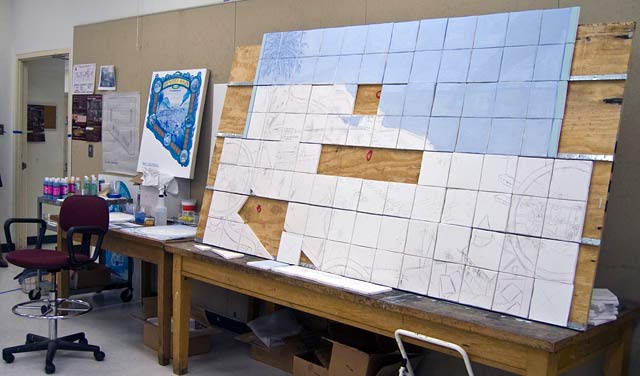
The mural at the end of the third demonstration.
- Today's plan is to complete the top of the mural. Pignolet will focus on the kelp leaves pattern in the border. Around 11 this morning, Birk starts filling in the sky in the main area of the painting. He applies color quickly, covering a large area in a thin layer. He strives for even coverage, without visible brushstrokes. Work on the "hard parts"--the painterly landscape in the center, begins afterwards.
- Birk explains more details on the mural's commission process--Percent for Art program applies to construction projects over $1M. The requirement can be satisfied by funding a work of art to be sited on or near the new building, or by making a donation to the city, which will disperse it to performing arts organizations.
- The initial screening for this project was based on written proposals and resumes. The final selection was based on slides of previous work. The design was developed after the Birk/Pignolet team was selected, and reviewed by a board comprising 6 to 8 people: Cultural Affairs Dept. officials, architects, lifeguards, a couple of community members.
- The overall design was liked immediately, but the lifeguards on the review board asked for changes to the roundels in the border, which now depict: decompression chamber, outreach programs educating young swimmers, rock climbing, specific helicopters, vessels and land vehicles used out of the Catalina facility, and an image of a rescue operation taken from a video shot by the lifeguards.
- During painting of the decorative elements, Birk departs at time from the initial design to improve on it. The detailed, 50-pages contract with the City makes allowance for the handmade nature of the work, acknowledging that some changes from the approved proposal will occur. On the other hand, if variants in the final work become contentious, the technique employed proves advantageous because the objections can be accommodated by simply replacing a tile.
- Tiles affixed to the steps of the building next to the mural will expand on lifeguard lore, including a poem found in a lifeguard history book, symbols used in training, and the original morse code for distress calls (CQD--remembered by the mnemonic Come Quickly, Danger). The latter was eventually replaced by SOS (which features prominently on the mural itself).
- Dan Pope, FC ceramics instructor, provides an explanation of underglaze paints--how the color will shift in firing, and the need to add a glaze for protection and to impart saturation and glossy finish. Color shift is such that the two blues (medium and dark) which Birk and Pignolet selected for this project look identical when poured out of their containers. The colors are somewhat transparent--Birk mentions that the darkest areas will receive four coats, lighter areas correspondingly fewer. No real blending is possible--value must be built up in layers.
- All the tiles were numbered on the back before painting started. The numbering was written in such a way so as not to burn off in the kiln like the the pencil drawing on the front of the tiles. The numbering will also serve as a guide for installation.
- The mural will be installed over the scratch coat on the external wall of the building. The surrounding area will be finished with stucco.
- The tiles are currently touching on the rack. The artists would normally leave gaps to account for the grout, but the limited space available on the rack forced them to crowd the tiles to fit more in. As painting progresses, they in fact take down some tiles to make room for the ones on the edge of the image. Less than half the tiles in the mural fit on the rack at any one time. Also, the size of the grout is not known at present--the professional tile installer that will mount the mural on the building will determine that.
- Transfering the drawing to the tiles took about four hours. A photograph of the design was projected on the tiles in a darkened space in the artists' loft.
- Two previous mural projects (titled Discovery of the City of Long Beach), already installed in a downtown plaza in Long Beach, are 16' x 16' and 12' x 12' and involved over a thousand tiles. Those were all hand-made by Pignolet while working at a ceramics studio. Since she no longer has access to the facility, and to save time, the tiles for the current project--while still handmade--were purchased from a distributor.
- Another, much larger tile mural, demonstrates the vagaries of public art--a project that was supposed to wrap up in two years has been dragging on for five. The artists have to bear added costs for storage of the work, entirely completed but yet to be installed on a new LAPD station in Boyle Heights. The tiles went directly into storage after coming out of the kiln and have not been seen all at once, in their entirety. Due to its size, the work was executed at a ceramics factory's warehouse in Long Beach.
- Birk remarks that the fate of the many murals painted around Los Angeles for the 1984 Olympics--irreparably defaced by graffiti--demonstrates that paintings on exposed walls are far too fragile. Tile murals are a more viable option.
- The 4' x 8' woodblock prints concerning the Iraq War, now in Heidelberg, were too large for a printing press and had to be printed by hand-rubbing at RISD, in editions of two (which actually totals five copies, including the proof, the print for the artist, and the one for the printshop's archives).
- Also in the show in Heidelberg, Birk and Pignolet's series of drawings relating to 9/11 depicting the airports involved in the terror attacks--the departure locations and intended destinations of the planes.
- Pignolet won the scholarship that took her and Birk to Portugal to study ceramic tiles. The large, detailed murals they saw there were a major inspiration for the present work.
- Style for Birk follows the concept. He does not set out with a preconceived style in mind--he develops the visual treatment to complement the idea driving the project. Hence, the stylistic difference between the various series of images he has created.
- Inferno was the first time Birk based a project on a literary source. The second is the upcoming Quran project--after five years of complete immersion in the Divine Comedy, Birk needed a break from both Dante and Catholicism.
- Birk is currently reading 2666 by Roberto Bolaño (Chilean, lived in Barcelona, died of cancer 5-6 yrs ago). Has a big affinity for Latin American writers. Read Jorge Amado and other Brazilian authors as he learned Portuguese while living in Brazil for 4 years. He also found out about José Saramago after the Portuguese writer won the Nobel prize, and has now read several of his books.
- While preparing for the Quran project, Birk and Pignolet visited Morocco twice. Did research at the Arab World Institute in Paris, as well as the Dublin library mentioned earlier. They have no further trips lined up presently--in future travel plans, they'll try to stay near the beaches.
- Birk's usual routine includes surfing at least five days a week. He wakes up no later than 8 and checks the weather through the Internet before heading to the beach. Huntington Beach, Surfside are the most convenient locations--with decent conditions even on the worse days. But on good days he goes to Malibu for the best waves. From approximately noon he takes care of emails, public art applications, and other business matters. He strives to put all that aside by 3 and paint until about 8. Since he and Pignolet work out of their home, they usually wrap up the day going out.
- The Tower of Babel, an oil painting by Pieter Brueghel the Elder, was an influence behind Birk's painting of the mountain of purgatory on the cover of the Purgatorio book. For Pignolet, the history of ceramics is the strongest influence currently, but she draws on a variety of sources, from gallery and museum visits to the graffiti in her neighborhood.
- Both Birk and Pignolet have big files of rejection letters. Having a thick skin is essential to be able to pursue an art career. Also, be aware that not all rejections imply a negative response--some submissions simply don't get looked at. Birk was approached by the Koplin Gallery and currently exhibits there regularly--but this is the same gallery that had previously rejected three submissions by him. Gallery staff claim not to to recall the work he had sent in.
- After two shows with McGrath, Birk showed at the Bess Cutler Gallery (now out of business) in Santa Monica. Having a record of three shows then attracted attention from more prestigious venues.
- Birk often starts a project by going to the library--which he finds faster and more in-depth than searching on the Internet. After reading books about the Gold Rush, a time when California was depicted as the promised land, he heard a news report on California's rate of incarceration--the highest in the world. He was struck by the contrast between the idealized past and the reality of today, and further realized that the huge corrections operation is largely invisible to the average Californian. He sought out and traveled to many of the 33 state prisons, several federal penitentiaries, and innumerable local jails, where he developed his series of paintings on this topic.
- Birk doesn't ever set out to deliberately "ruffle feathers"--though controversy may eventually happen. Pignolet remarks that there were unexpected reactions to who and what they chose to put in hell in the Inferno movie. Mentions specifically some strong objections to Dean Martin's presence, and a scene located in a gay bar.
- Work on commission definitely puts limits on creativity--the subject matter may be entirely different from the things they would chose to work on. They do make sure that the work is something they can nonetheless be proud of.
Wednesday, March 18, 2009, 9 am.
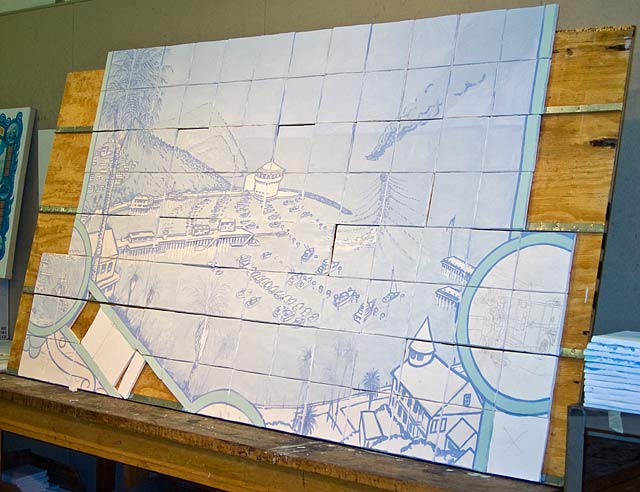
The mural at the end of the fourth demonstration.
- For today, the goal is to complete the landscape. The work is evolving beyond contour drawing and solid fills. Birk starts by adding shading to the hills on the top-left. Uses fewer coats for the more distant hills so they will turn out lighter to enhance depth through aerial perspective. For white areas, he will leave the bisque exposed. The border tiles are now off the rack, stacked and awaiting a coat of glaze.
- A new color test was fired today in one of the Fullerton College kilns. Birk states he is now confident that the results will match what they had envisioned.
- The tiles with diagonal cuts were cut with a water saw. The job was done by the vendor at the time the tiles were purchased. Some additional cuts are needed, however. Dan Pope advises to cut before firing--any mistakes after firing would require firing again.
- Birk has never used Photoshop. He doesn't use the computer for anything beyond occasionally cropping and projecting. He is not opposed to computers, but at this point in his career he doesn't find it worthwhile to set aside the time to learn when he already has an effective workflow.
- Demand for public art so far has not been diminished by the economic downturn. The Percent for Art is a legal requirement, so it will continue unabated unless construction stops.
- Birk has filed away newspaper photos for years--reference images for people, buildings, cars, etc.
- Birk is not concerned about copyright infringement for one-of-a-kind artwork. He believes it would be OK for him to put "an exact copy of Mickey Mouse" in one of his paintings.
- Birk advises to keep as much of the rights as possible. For the current project, the rights arrangement is a standard set by the city, which is quite good for the artist (overall, the Cultural Affairs Dept is on the side of the artist, as they are tasked with encouraging creative activities). The City will own the artwork, but there are limits on what can be done with it, and restrictions on tearing it down. Also, while the city contract does allow reproduction of the image of the mural to promote the Cultural Affairs Dept., all other rights to the image are retained by the artist. That is generally the case whenever an artist sells a painting--the buyer does not have the rights to make, say, T-shirts with the image, or other derivative works. In a recent instance, a publisher wanted to use one of Birk's paintings in a book--and contacted Birk for permission, since he retains the rights to the image itself.
- Each of the three galleries representing Birk--Koplin Del Rio (LA), Catharine Clark (SF), P·P·O·W (NYC)--represents about twenty artists.
- Birk worked in surfboard shops while in high school, painting surfboards (paid $5 per color--if the customer wanted a yellow stripe and a red one he'd get $10). Later, traveling in Latin America with a shaper (person who builds the boards), he also painted surfboards in Brazil (PowerTools Surfboards) and Peru. Chicama's beach, north of Lima, is legendary among surfers for having the longest waves in the world.
- The surfboard paintings that Birk did were always painted on the foam (masked and sprayed). It is also common to paint on the sanding coat, then adding the shiny coat. For a while though (80s and 90s) there was a trend towards not adding a shiny coat to keep the weight down, but that changed again with the introduction of lighter materials.
- When Birk was in high school it was common to use car paints, which dry quickly (same stuff as nail polish) and do not bleed when covered with resin. However, the range of colors is limited--and the stuff is highly toxic.
- Surfboards are highly disposable because they deteriorate quickly with heavy use. Hardcore surfers replace theirs every three months. Therefore not worth investing much on decoration. There may be a market for collectible surfboards, but Birk is not involved.
- Birk lived in the Rampart precinct (Echo Park, East Hollywood) while the LAPD scandal unfolded. He was so horrified, it drove him to make the series on Rafael Pérez patterned after William Hogarth's A Rake's Progress.
- Birk has an upcoming show at the San Diego Museum of Contemporary Art in April-May, and another one in L.A. in September.
- Birk and Pignolet's live-work space in Long Beach is a loft about 2,000 sq ft, half of it dedicated to studio use. Pignolet, who studied at CSULB, has an additional smaller space nearby. Because of the dust involved, they do not work on ceramics in their loft--they rent space for each project at a ceramics factory.
Wednesday, March 18, 2009, 1 pm.
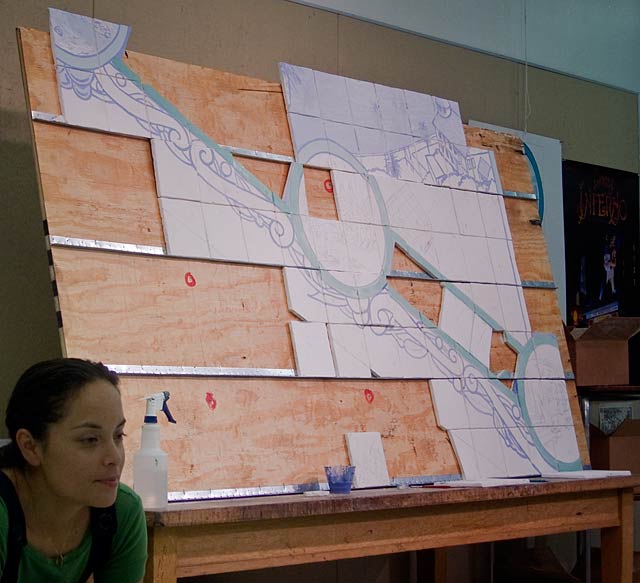
Elyse Pignolet and the mural at the end of the fifth demonstration.
Thursday, March 19, 2009.
- Birk continues painting the lower portion of the landscape. Due to the slant of the lower edge of the mural, fewer tiles fit on the rack now. Pignolet, working on tiles laid flat on a table, is focusing on the roundels set in the border of the mural.
- Birk doesn't feel he's deliberately denigrating Los Angeles. He paints out of his experience. If there are violent themes in his work, they emerge from that experience. 7th and Alvarado (in the Westlake neighborhood where the Otis Art Institute was located) was considered the most dangerous corner in Los Angeles at the time he attended the school.
- Birk likes the city and has also painted positive images of it (such as the current project). He's fascinated by the diversity of the city--he once saw a woman coming out of a convenience store, balancing her purchase (a sixpack) on her head--the way she probably would do in her village. Birk made a painting of that episode.
- Birk's most used medium is oil and acrylic, but it's not necessarily "the favorite".
- Men in the Cities paintings by Robert Longo--Birk thought they were contrived, forcing bizarre poses just for effect. He contrasted that with the notion of skaters as the true 'men in the city'. The absence of the actual skateboard in some of Birk's skater images (thus focusing on the human figure) establishes the visual connection with Longo's work.
- Birk is not involved in pricing his work. The galleries handle that, which is more appropriate because they have a better sense of the art markets.
- The Inferno script had to be very detailed because specific versions of each puppet had to be created for each shot, so they could not improvise.
Friday, March 20, 2009.
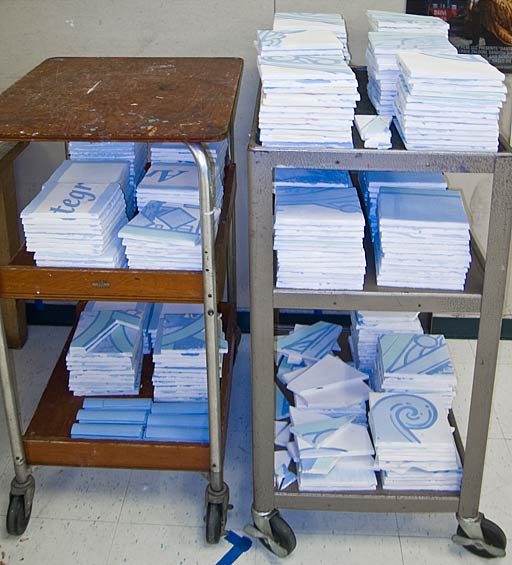
Mural tiles after completion of painting, awaiting glazing and firing.
- Birk and Pignolet returned after the end of the scheduled visiting artist program, completing the painting of the Avalon mural, as well as the over 80 tiles to be set in the steps of the staircase next to the mural's location.
- During this additional session, they were also able to complete a second, smaller mural for a private commission.
Saturday, March 21, 2009.
- Birk and Pignolet completed their work for the week by coating the tiles with glaze. The pink substance, once fired, will become a clear, glossy covering for the mural.
- Bill Henke, seen on the right as he finalized preparations, loaded one of the kilns in the Ceramics yard with the tiles, and lit its burners at low intensity to dry out the load. He returned later in the evening to seal the kiln and raise the heat for firing.
Sunday, March 22, 2009.

The larger kiln in the center is the one used for this project.
- Bill Henke returned late on Sunday to shut down the kiln and begin the cooling phase.
Tuesday, March 24, 2009.
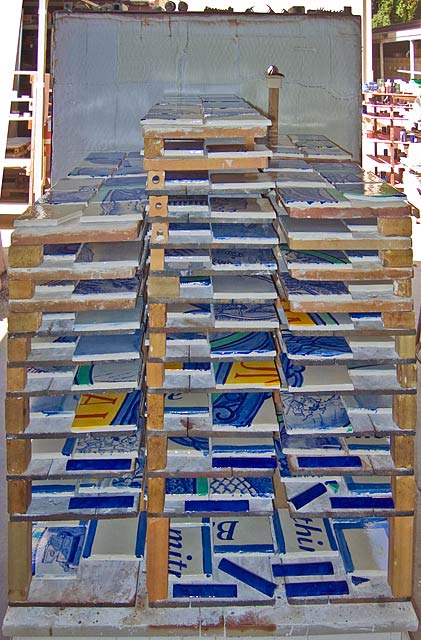
The tiles on the kiln shelves after firing.
- The kiln continued to cool down throughout Monday. Bill Henke opened it at 11 am on Tuesday.
Fullerton College, Wilshire Theater
Tuesday, March 17, 2009, 7 pm.
- Birk likes to work sequentially on his ideas, exploring each new idea exhaustively before moving on to the next project. Each idea develops into a series of images.
- Surfing paintings
- South-central paintings
- Los Angeles riots paintings
- War of the Californias paintings
- More info on items discussed during the demonstrations
- Avalon Lifeguard Headquarters public art description and design
http://www.lacountyarts.org/civicart/04_Fourth_District/birk_avalonlifeguard.htm
- Landscape with the Fall of Icarus, once attributed to Pieter Brueghel the Elder
http://en.wikipedia.org/wiki/Landscape_with_the_Fall_of_Icarus
- Underglaze colors
http://en.wikipedia.org/wiki/Underglaze
- Ceramics firing, pyrometric cones reference
http://www.ortonceramic.com/resources/reference/cone_ref.shtml
- Azulejos (blue-white tiles)
http://en.wikipedia.org/wiki/Azulejo
- Heidelberger Kunstverein (in German)
http://www.hdkv.de
- Metro Orange Line's public art
http://www.metro.net/press/2005/10_october/metro_160a.htm
- Gustave Doré's illustrations for Dante's Inferno
http://www.doreillustrations.com/divinecomedy/HELL/8779-h.htm
- In Smog and Thunder, the Great War of the Californias
http://www.insmogandthunder.com
- Dante's Inferno
http://www.dantefilm.com
- Sandow Birk's Leading Causes of Death in America
http://www.tfaoi.com/aa/6aa/6aa24.htm
- Sandow Birk's California prisons paintings
http://artscenecal.com/ArticlesFile/Archive/Articles2001/Articles0701/SBirkB.html
- Clothespin, by Claes Oldenburg, 1976
http://en.wikipedia.org/wiki/File:City_hall_and_clothespin.JPG
- Los Angeles Cultural Affairs Department, Public Percent for Art Program
http://www.lacity.org/CAD/publicart/publicpercent.html
- Sandow Birk's The Revenge of Lorena Bobbitt
http://www.sandowbirk.com/004.html
- Earl McGrath Gallery
http://www.earlmcgrathgallery.com
- The Qur'an Collection, Chester Beatty Library, Dublin
http://www.cbl.ie/Collections/The-Islamic-Collection/The-Qur-an-Collection.aspx
- CQD distress signal
http://en.wikipedia.org/wiki/CQD
- Sandow Birk's The Discovery of the City of Long Beach
http://www.artspca.org/public_art/discoveryoflb.shtml
- José Saramago
http://en.wikipedia.org/wiki/Saramago
- Arab World Institute, Paris (in French)
http://www.imarabe.org
- The Tower of Babel by Pieter Brueghel the Elder
http://en.wikipedia.org/wiki/Tower_of_babel_(brueghel)
- Koplin Del Rio Gallery
www.koplindelrio.com
- Catharine Clark Gallery
http://www.cclarkgallery.com
- P·P·O·W Gallery
http://www.ppowgallery.com
- Chicama, Peru
http://en.wikipedia.org/wiki/Chicama
- Rafael Pérez and the LAPD Rampart scandal
http://en.wikipedia.org/wiki/Rafael_P%C3%A9rez_(police_officer)
- William Hogarth's A Rake's Progress
http://en.wikipedia.org/wiki/A_Rake%27s_Progress
- Men in the Cities paintings by Robert Longo
http://www.robertlongo.com/work/gallery/1118